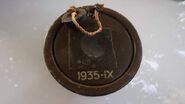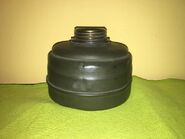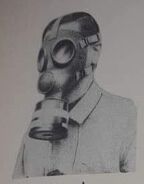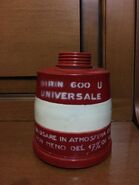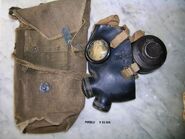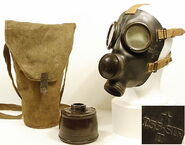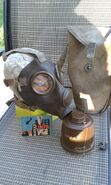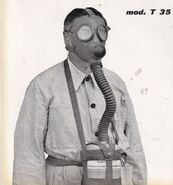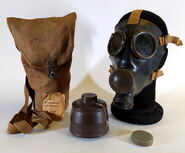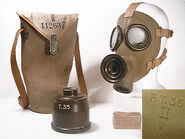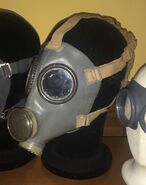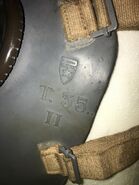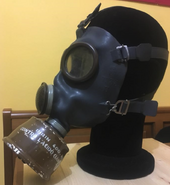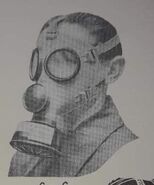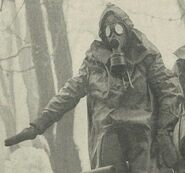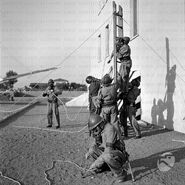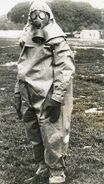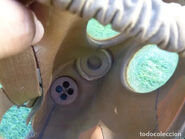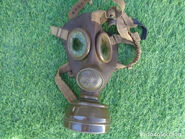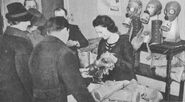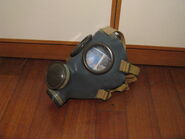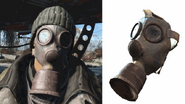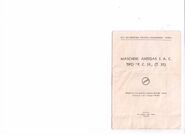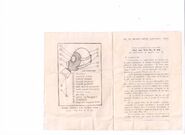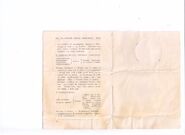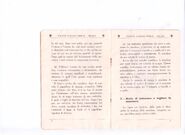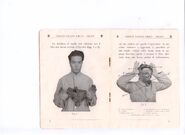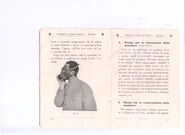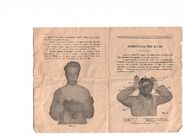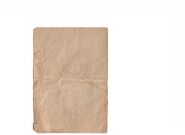The T.35 was the standard military gas mask of the REI (Regio Esercito Italiano, royal Italian army) from 1935 until the adoption of the M59. This mask was widely issued from 1935 until the early '60s to soldiers, civil protection, firefighters and industries. The last T.35s used were around the late '70s.
Mask overview
The facepiece is composed of the following parts:
The faceblank is made of a moulded rubber to which the following are attached:
- the housing for the exhale valve
- the metal threaded piece that allows the filter to be screwed in and houses the exhale valve
- the eyepieces
- the straps
The inhale valve, which allows filtered air in from the filter and does not allow exhaled air to go back out from the filter again. Said rubber valve is housed in the metal threaded piece.
The exhale valve allows exhaled air to go outside and prevents poisoned air to get in. It's made of rubber, it opens under the light pressure of exhaling and closes hermetically under the negative pressure produced by the inhalation. It can be easily inspected and possibly replaced by unscrewing the lid of its housing.
The eyepieces are made of "Triplex" glass, which itself is composed of two glass layers and a thin sheet of cellulose. This kind of glass prevents poisoned air to get into the mask even after being hit, as only the outside layer of glass would be shattered and the other two layers would maintain the seal. The glasses are affixed to the mask through aluminium frames.
The elastic harness has the goal to keep the mask tightly onto the face. It is composed of 5 adjustable straps (a top one, two elastic temple ones and two elastic cheek ones) attached to the facepiece, and they gather into a nape pad.
The anti-fogging disks are kept tightly onto the lenses by metal inserts and serve the purpose of maintaining good visibility.
Differences in production styles
The T.35 designation includes two slightly different designs:
- S.C.M. license n. 9 of 17th May 1935 released for I.A.C.
- S.C.M. license n. 10 of 23rd November 1935 released for Pirelli
The differences between these two designs are the shape of the "nose" section, the kind of rubber used and the different threaded piece, with the I.A.C. one being deeper and allowing for an internal seal to be placed without shortening the available thread. I.A.C. facepieces have a double layer of rubber fused together, with only Pirelli licensed I.A.C. T.35 masks as an exception.
Other 3 companies made T.35 masks, under either Pirelli license, I.A.C. license or a mix of the two. Superga and Spasciani made T.35 masks in the same form as the Pirelli one, the only difference being the rubber used. S.I.G.L.A, instead, used the Pirelli pattern faceblank shape with I.A.C. furniture and similar rubber.
I.A.C. also made T.35 masks under Pirelli license, with mostly I.A.C. furniture (the only exception being the threaded piece) and a single rubber layer instead of two.
Sizes
The T.35 comes in three sizes, with 1 (I) being the largest, 3 (III) being the smallest and 2 (II) being the average one. The size is marked on the left side of the mask with a roman number.
Markings
On the left side of the mask, besides the mask name and the size, there is the company's marking and sometimes a series of dots of unknown meaning. On the right of the mask, there is the register number, and on the inside, under the right eyepiece, there is another register number.
The T.35 was produced by various companies during multiple years.
The main producers of the T.35 were:
- Pirelli
- I.A.C. (Industrie Articoli Caucciù, rubber items industries)
- Superga
- S.I.G.L.A. (also referred to as Sacic incorrectly, as its a different branch of Pirelli located in Belgium)
- Spasciani
Conservation
To preserve the mask, the manual recommends wetting the exhale with a solution of 30 % of glycerine and to keep the mask in a dark, dry and cool place, with little temperature range.
Filters
Army
T.35
The standard T.35 filter was a brown-painted metal container containing the various filtering substances, which were mainly activated charcoal and pumice for the adsorbing layer while the particulate layer was made of resin-impregnated wool and viscose rayon. Filters issued to some corps were coloured differently, such as the ones issued to the UNPA, which were yellow.
SCM-41
In 1941, Italian soldiers fighting in Africa were issued with the special SCM-41 filter, designed to work best under torrid environments. It sported an external rubber seal that allowed it to be used with Italian masks. This filter continued to be issued after the War. This filter was issued also after the war until the '60s to both T.35 and M59 masks.
M.42
In 1942 a new type of filter made and issued, the M.42 filter: it was lighter and a bit more efficient, and it would be used alongside the older T.35 filters until the M58 filter came along much later.
Civilian
Civilian masks were issued with their own companies' dedicated filters, which usually beared the same name of the mask. These filters are usually painted yellow or orange. For more info check the variants' list in this page.
Industry
T.35 masks used industrially were issued with a specific filter for the gas they had to protect the user from. The kind of filters used with this mask were the one with a 40 mm thread, and some times a hose was used to facilitate the use of larger filters. Some times, surplus masks were used with standard military filters or civilian ones.
Fire brigade
The firefighters issued with this mask usually had either a regular T.35 filter or a universal industry-grade one made specifically for firefighting and usually painted red: one example is the Dirin 600U, a Pirelli filter.
Kits
Army and statal corps
Regular military kit
The regular military kit, widely issued to the Army and other corps. The mask and the filter were kept in a simple hemp bag with a single strap. Inside the same bag, there were a manual, an envelope containing the anti-fogging lenses and a small box containing a spare exhale valve. When unopened, both the filter and the mask were wrapped in paper, and the tab that closes the bag was tied with a string that had the company's logo attached.
Spasciani kits had their spare exhale valve and anti-fogging lenses in the same small box.
The navy kit did not differ in the content of the bag, the only notable differences are the filter, which has a paper sheet attached to it where the issue number and unit the mask was issued to. On the bag itself, there was a small pocket that allowed a tag to be put in, which showed name, issue number and unit of the owner of the mask. Early navy kits were issued with a regular T.35 bag.
Cardboard box kit
Some S.I.G.L.A. T.35R were issued with a cardboard box that had a single strap and a cardboard lid. This kit consisted of the mask, the filter, an envelope containing the anti-fogging lenses and a small box containing a spare exhale valve.
M.42 kit
This War-time kit had the same accessories as the regular kit, but it was issued with an M.42 filter (supposedly, most were issued with a T.35 filter) and an M.42 bag. The M.42 bag had extra pockets at the front and one in the back; they allowed better storage of the kit and the possibility to keep a protective sheet.
U.N.P.A. kit
The U.N.P.A. was issued with uniquely marked T.35 masks and T.35 filters, the latter of which could have been either yellow or the regular brown. The carrier used was either the metal one or the regular hemp bag.
Post-War kit
After the war, the mask was usually issued with the same kit as the regular one. Training kits were issued usually with an SCM-41 filter.
Civilian
Civilian T.35 variants sold had their own companies' dedicated kit, while freely issued civilian masks had standard kits, regardless of the producer. These kits can be seen in the variants section of this page.
Industry
Industrial T.35 masks were issued with a range of different kits, which depended on the customer's choice. The filter was usually an industrial one specific to the threat faced, but some times after the war regular T.35 filters were used, too. Large filters like the Tubin usually had a hose and a cage carrier to carry them around. Sometimes T.35 masks were issued with the regular hemp bag, other times with a metal box. Some kits also had anti-fogging lenses and filter use timers.
Fire brigade
The pre-War fire brigade T.35 kits usually consisted of a military T.35 with a regular T.35 filter and a T.35 bag marked "V.V.F.". After the War, the mask used were mostly Post-War production T.35 mask with Dirin 600U filters.
Variants
Civilian variants
P.C. 35 Popolazione civile 35, civil population type 35
9th gas mask approved by the S.C.M. (Servizio Chimico Militare, chemical military service) on 17 May 1935.
The P.C. 35 was I.A.C.'s civilian counterpart to the military T.35. It differed from the aforementioned by having only one layer of rubber and a slightly different pattern of nape pad. Its kit comprised of the mask, its dedicated P.C. 35 filter, its manual, a training thread, an envelope containing the anti-fogging lenses, a small box containing a spare exhale valve and a dedicated bag, which was identical to the T.35 one except for a pocket in the front that served the purpose of keeping the anti-fogging lenses.
Pir. 35 Pirelli 35
10th gas mask approved by the S.C.M. (Servizio Chimico Militare, chemical military service) on 23 November 1935.
The Pir. 35 was Pirelli's civilian T.35 variant. It was virtually identical to its military counterpart. Its kit comprised of the mask, its dedicated Pir. 35 filter, its manual, a small box containing a spare exhale valve and either a T.35-style bag or a metal tube carrier, depending on the buyer's needs.
R.S. 37 Riccardo Spasciani 37
16th gas mask approved by the S.C.M. (Servizio Chimico Militare, chemical military service) on 1 March 1937.
The R.S. 37 was Spasciani's civilian T.35 variant. It was provided with a dedicated R.S. 37 filter, a box containing a spare exhale valve and anti-fogging lenses, and a T.35-style bag.
P.C. 40 popolazione civile 40, civil population 40
The P.C. 40 was the cheapest variant of the T.35 ever devised, and it was issued for free to the civilian population. It had thinner rubber, cellulose glasses and aluminium parts.
The mask came in two different kits: most masks were stored in a cardboard box and came with the filter, a stick of anti-fogging soap and the manual. Some masks had a dedicated cheaper variation of the T.35 bag and had the same accessories.
After the war, the P.C. 40 started being produced to a higher standard, but the purpose of this Post-War variant is unknown.
Military variants
T.35R
The T.35R was a variant of the regular T.35 that differed only in the use of a double layer of rubber, with black rubber on the inside and a lighter-toned one on the outside (usually dark beige). This variant was produced shortly before and during the War.
T.35Rs
The T.35Rs, like the T.35R, was a variant of the regular T.35 that differed only in the use of a double layer of rubber, with black rubber on the inside and grey rubber on the outside. This variant, like the T.35R, was produced shortly before and during the War.
T.35-SIR
This variant of the T.35 was made using a new kind of black, synthetic rubber and sported an M42 filter and the upgraded M42 satchel.
F.T.35 Fonica Tipo 35, phonic type 35
This variant had a trumpet in front of the exhale valve to enhance the voice of the user and was provided with a tissot system to prevent fogging. This kind of masks were used by the Navy. F.T.35 masks were produced by Pirelli, Spasciani, S.I.G.L.A. and I.A.C., the latter of which marked them as T.35F. and used a slightly different facepiece mould. Those masks were issued with a navy kit.
Post-War variants
After the War, the pre-War T.35 was still widely issued and many masks were used as surplus by industries.
But yet, new T.35 variants were devised and used, mostly by industries and non-military corps, as the army still had plenty of T.35 masks to use.
Post-War Pirelli T.35 masks
After the war, T.35 masks made by Pirelli were manufactured with a new kind of rubber and were mostly used by industries and firefighters.
First version
The first type of post-War Pirelli T.35 production was almost the same as the original, just made to a better standard with the newly implemented rubber compound.
Second version
The second version of the post-war Pirelli T.35 had some slight differences to its predecessor, as the regular straps system was replaced in favour of a hook system and full rubber straps.
RS-37
sample text
Hooded variants
SIP 6
The SIP 6 was a hooded variant of the T.35, and it was made with white rubber. The mask sported a hook system with rubber straps outside its rubberized hood, which could be made impermeable with "revisite" if requested. This mask was used by industries when there was the risk of corrosive splashes.
Service life
Development
During the '30s the Italian Army was seeking renovation in its chemical protection equipment, replacing the Penna respirator with newer, better masks.
The first mask developed as a replacement was the M.31, quite similar in setup to the Penna, having a hose and a chest-placed satchel. During the next year, the development of a new concept started and chin-mounted filters were starting to have an appeal to the army, and they would for the next 70 years. The T.32 gas mask was tested in that period but did not see official adoption due to unknown reasons, yet its derivative, the Pr.C. 33, saw some use within the ranks of the Opera Nazionale Balilla (national Balilla operation, a fascist youth organization).
During the 3 years after, the two main companies selling gas masks to the army (Pirelli and I.A.C.) provided two similar designs for a military mask with a chin-mounted filter. As both designs were fit for their purpose, in 1935 they would be officially adopted under the same designation, T.35.
Adoption
This new mask was fit for multiple porpuses, and because of that was widely issued to most places were a gas mask was needed: the fire brigade, the UNPA (Unione Nazionale Protezione Antiaerea, national air-raid protection union) and the Carabinieri (military police) were all issued this mask. The army issued a lot of these masks but never fully replaced the M.31 and the M.33, which continued to be produced.
The Navy, which at the time had issued various masks (R.M.2, R.M.3, R.M.F.), adopted the T.35 only for terrestrial duties. To better fit the Navy's needs, a modified variation of the T.35 incorporating the same phonic device as the R.M.F. was devised and adopted as the F.T. 35. Later, the R.M.F. 35 would be made with features from both the R.M.F. and the F.T. 35.
Conflicts
The first major conflict this mask saw use in was the Spanish Civil War. Italian soldiers fighting there were usually issued with a T.35, an M.33, an M.31 or, on rare occasions, with a Penna respirator. When T.35 masks fell in other-than-Italian hands, they were usually converted to use German-style 40 mm filters, a conversion that usually consisted in adding an extra thread at the bottom, completely replacing the intake piece or just adding a gasket to I.A.C. T.35s, the thread of which has the space to do so. After the War, the Spanish Army used T.35 masks for a short while until it was ruled out of service in favour of another mask.
During the Second World War, the T.35 was brought in every battlefield alongside the M.31 and the M.33, but it never saw real use, as no gas was ever dropped during the conflict.
Post-War military and statal corps' use
After the end of the War, the army ruled M.31 and M.33 masks out of service and stuck with only T.35s alongside American M9A1s. These masks were used by every branch until the adoption of the M59, which slowly replaced them in every place, starting from the army. The latest the T.35 was seen being used by any military corp was during the late '70s.
Civilian use and further development
The T.35, or more precisely, the Pir. 35 and the P.C. 35, were allowed to be sold directly to civilians, as other masks already were. Those models were required to show S.C.M.'s license on the side of the mask. After some time, Spasciani presented its own civilian T.35, which was the R.S. 37, a licensed copy of the Pirelli pattern.
During 1940 a new type of T.35 was issued for free to the civilian population, it was much cheaper and had thinner rubber, cellulose glasses and aluminium parts. The designation was P.C. 40 and it was produced by Pirelli, S.I.G.L.A. and Superga.
After the War, P.C. 40s were produced with a new kind of rubber and Triplex glasses, for an unknown motive. A successor of this was devised and produced, with a rubber harness sporting a hook system and integral tissot tubes, its designation was P.C. 50 and its use was as mysterious as the post-War P.C. 40.
Industrial use
Before the War, T.35 masks were used in industry as much as other industrial masks, and they were issued with threat specific filters. After the War though, there was a great surplus of military masks, and those became widely used in various industries, some times with threat-specific filters, some times with regular T.35 ones. New variants were devised and used, before and after the war, such as the SIP 6, the hooded variant.
After the years, T.35 masks and their variants were slowly ruled out of industry.
Hungarian use
Pirelli made T.35 masks were exported and used by Légoltalmi Liga (the predecessor of Polgári védelem - Civil Defence) as Gumi munkagázálarc (Rubber work gasmask) from 1938 to 1945. After the War, the mask was used in the industry.
Copies
- Around the time of the Spanish civil War, some local shops made knockoff versions of the T.35. Those had a 42 mm thread and were used by the Republicans mainly.
- Some T.35 copies are rumoured to have been made in Yugoslavia, though no proof has been found yet.
T.35 and the Media
sample text
- The T.35 can be commonly found in Fallout 4 as the gas mask with goggles, although its presence there would be unlikely in real life, even without the hindrance of total atomic annihilation.
- The T.35 can be seen worn by Cristina Blackwater (model) in the Blood Shake musical video by Dope D.O.D and Salmo.
- The T.35 can be seen worn by various actors in the Tapparella musical video by Elio e le Storie Tese.
Videos
- 1958 coluor video of firefighters training T.35 masks with DIRIN 600U filters can be seen after the 1:16 mark.
- 1942 air-raid training T.35 masks can be seen amongst other masks in various scenes.
- Training in the mountains during the Second World War T.35 masks can be seen in the first part of this short video.
- Italian girls of the GIL parading, 1939 in the streets T.35 masks can be seen after 0:42 mark.
- 1973, Porto Maghera's strike to complain about the mandatory use of gas masks Various masks, including the T.35, can be seen being worn by protesters.
I.A.C. P.C. 35 manual
Pirelli T.35 manual
The pictures used here are actually of a T.32 and not a T.35, but those two masks don't differ operationally so the same pictures could be used multiple times.
Spasciani T.35 manual
Spasciani-made manuals used pictures taken by Pirelli.
Post-War T.35 unit manual
sample text









